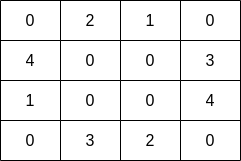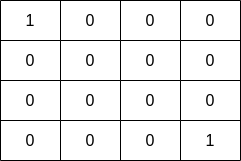LeetCode in Kotlin
2658. Maximum Number of Fish in a Grid
Medium
You are given a 0-indexed 2D matrix grid of size m x n, where (r, c) represents:
- A land cell if
grid[r][c] = 0, or - A water cell containing
grid[r][c]fish, ifgrid[r][c] > 0.
A fisher can start at any water cell (r, c) and can do the following operations any number of times:
- Catch all the fish at cell
(r, c), or - Move to any adjacent water cell.
Return the maximum number of fish the fisher can catch if he chooses his starting cell optimally, or 0 if no water cell exists.
An adjacent cell of the cell (r, c), is one of the cells (r, c + 1), (r, c - 1), (r + 1, c) or (r - 1, c) if it exists.
Example 1:

Input: grid = [[0,2,1,0],[4,0,0,3],[1,0,0,4],[0,3,2,0]]
Output: 7
Explanation: The fisher can start at cell (1,3) and collect 3 fish, then move to cell (2,3) and collect 4 fish.
Example 2:

Input: grid = [[1,0,0,0],[0,0,0,0],[0,0,0,0],[0,0,0,1]]
Output: 1
Explanation: The fisher can start at cells (0,0) or (3,3) and collect a single fish.
Constraints:
m == grid.lengthn == grid[i].length1 <= m, n <= 100 <= grid[i][j] <= 10
Solution
class Solution {
fun findMaxFish(grid: Array<IntArray>): Int {
val visited = Array(grid.size) { BooleanArray(grid[0].size) }
val dir = arrayOf(
intArrayOf(0, 1),
intArrayOf(0, -1),
intArrayOf(1, 0),
intArrayOf(-1, 0),
)
fun isValid(x: Int, y: Int) = x in (0..grid.lastIndex) && y in (0..grid[0].lastIndex) &&
grid[x][y] != 0 && !visited[x][y]
fun dfs(x: Int, y: Int): Int {
if (!isValid(x, y)) {
return 0
}
visited[x][y] = true
var total = grid[x][y]
for (d in dir) {
total += dfs(x + d[0], y + d[1])
}
return total
}
var res = 0
for (i in grid.indices) {
for (j in grid[0].indices) {
if (grid[i][j] != 0) {
res = maxOf(res, dfs(i, j))
}
}
}
return res
}
}

